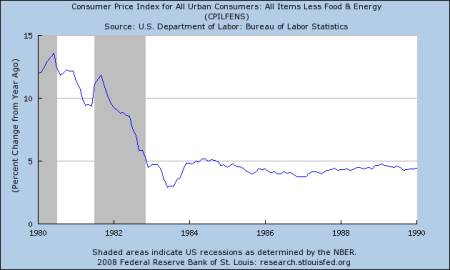Here is Wayne McCaffery’s excellent take on the Phillips Curve for AP instruction.
This is saved as a Google document so download it to see it perfectly. If you just view it, the document will appear juggled. My EconEdLink lesson on the Phillips Curve is here. After reading the links, answer this question.
> According to the long-run Phillips curve, which of the following is true?
> A. Unemployment increases with an increase in inflation.
> B. Unemployment decreases with an increase in inflation
> C. Increased automation will lead to lower levels of structural unemployment in the long run.
> D. Changes in composition of the overall demand for labor tend to be deflationary in the long-run.
> E. The natural rate of unemployment is independent of monetary and fiscal policy changes that affect aggregate demand.
Your answer should be “E”. If you answered “B” then you correctly understood the relationship of the Short-run PC. But the LR is a vertical line is independent of monetary and fiscal policies.
 A Luddite is someone who is afraid of technology. Technology scares people because they don’t know how to use it. In addition, workers fear that they will be replaced. The latter is true if the technology allows the employer to produce more will less workers. Sometimes a new innovation will allow a producer to produce more with the same amount. In this case technology enhances the worker. In the long run, after all costs have been internalized, technology does not affect the natural rate of unemployment. How long and what costs are involved in this long-run adjustment?
A Luddite is someone who is afraid of technology. Technology scares people because they don’t know how to use it. In addition, workers fear that they will be replaced. The latter is true if the technology allows the employer to produce more will less workers. Sometimes a new innovation will allow a producer to produce more with the same amount. In this case technology enhances the worker. In the long run, after all costs have been internalized, technology does not affect the natural rate of unemployment. How long and what costs are involved in this long-run adjustment? Microeconomics has taught me the power of marginal thinking. Marginal thinking is like the straw that breaks the camel’s back. The straw builds until a critical mass is reached then great breakthroughs are obtained. Tim Schilling, Powell Center for Economic Literacy, says that “thinking at the margin is the deal maker or deal breaker.” My personal mission statement is “to make daily marginal improvements.” If I make a 1% improvement daily, then over a year, I’ve make a 360% gain. This is significant. The picture is from
Microeconomics has taught me the power of marginal thinking. Marginal thinking is like the straw that breaks the camel’s back. The straw builds until a critical mass is reached then great breakthroughs are obtained. Tim Schilling, Powell Center for Economic Literacy, says that “thinking at the margin is the deal maker or deal breaker.” My personal mission statement is “to make daily marginal improvements.” If I make a 1% improvement daily, then over a year, I’ve make a 360% gain. This is significant. The picture is from 


